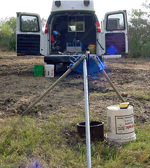 |
| Up-hole data acquisition system. |
A geophysical logging unit was purchased through the grant and is an essential tool in defining the proper procedures for the closure of abandoned wells. Since the beginning of the project, 201 abandoned or monitor wells have been logged. In addition to ensuring the proper plugging of the wells, SAWS is developing a comprehensive database of the subsurface geology of the San Antonio region.
The development of a Geophysical Well Logging Program by SAWS has been designed and implemented to provide a technical and scientific service to enhance and protect the quality of water resources that are supplied by SAWS. During the process of plugging abandoned water wells, it is essential to determine certain aspects of the well, such as casing size and depth, condition of the casing, borehole conditions and the formations the well penetrates. Once this information is collected, a plugging procedure can be formulated and the well can be plugged properly. SAWS also collects water quality information such as pH, conductivity, resistivity, and dissolved oxygen via the logging tools.
 |
| Information gathered from well logging has many benefits. |
In addition, this program promotes SAWS’ ongoing research of the area’s subsurface geology and has had a great deal of success in developing subsurface geologic cross-sections across the San Antonio region. All the wells that have been logged represent a piece of data that leads to the protection and understanding of the subsurface geology of the San Antonio region.
SAWS has assisted other agencies, such as the United States Geologic Survey, Texas Water Develop Board and San Antonio City Public Service during the drilling of their monitor wells. Once the geophysical logging information is gathered, the contractor that is plugging the well is informed where to set the gravel in the open hole, the cement plug to seal off the water-bearing formation, and how much material may be needed. By knowing these precise depths, the contractor can complete a proper plug.